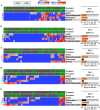A prospective comparison between multidisciplinary healthcare providers' clinical examination and a validated pain scale
- PMID: 36034751
- PMCID: PMC9411743
- DOI: 10.3389/fpain.2022.960216
A prospective comparison between multidisciplinary healthcare providers' clinical examination and a validated pain scale
Abstract
Introduction: Unrecognized pain in the Intensive Care Unit (ICU), due to inadequate assessment and therapeutic management, is associated with increased morbidity and mortality. Despite the availability of validated pain monitoring tools, such as the Critical-Care Pain Observational Tool (CPOT), these scales are not commonly used in clinical practice, with healthcare professionals often relying on their clinical impression. Our study aims to determine the agreement between the pain examination performed by ICU professionals and the CPOT.
Methods: Prospective cohort study that included critically ill patients and physicians, nurses and physiotherapists from an ICU in Bahia, Brazil. During bedside clinical rounds, the CPOT score was applied to assess the pain of hospitalized patients, and health professionals were interviewed to ascertain their perception of the patient's pain for a maximum of five consecutive days. Correlations were assessed using the Spearman rank tests. Hierarchical cluster analysis was employed to show the results of CPOT score and pain assessment by healthcare professionals at each study time. And the Kappa statistic was calculated to assess the agreement between the CPOT score vs. the pain assessment by healthcare providers.
Results: One hundred one patients were included in the study with median age of 74 years (IQR 61.5-83.5), a predominance of women (55.4%) and a median SAPS 3 score of 45 (IQR 39.5-53.0). The correlation between the professional's pain assessment and the CPOT were mostly statistically significant, ranged from negligible to weak, being the highest index obtained in the evaluation of nurses on day 5 (Kappa index = 0.43, p = 0.005). Physician assessments were significant only in day 1. On the presence of pain, the professionals' assessments and CPOT revealed mild to a moderate agreement.
Conclusion: Healthcare professional's pain assessment displayed a weak positive correlation with a validated pain scale and poor agreement amongst members of the ICU team, particularly when the pain was felt to be absent. Thus, this study highlights the importance of routine tools for pain assessment in the ICU for all members of multidisciplinary teams.
Keywords: Critical-Care Pain Observation Tool; critical care; pain; pain examination; pain management.
Copyright © 2022 Menezes, Silva, Arriaga, Ferreira, Carmo, da Silva, Otero, Gobatto, Agareno, Filgueiras Filho, Akrami and Andrade.
Conflict of interest statement
The authors declare that the research was conducted in the absence of any commercial or financial relationships that could be construed as a potential conflict of interest.
Figures


References
-
- Chanques G, Sebbane M, Barbotte E, Viel E, Eledjam J-J, Jaber S. A prospective study of pain at rest: incidence and characteristics of an unrecognized symptom in surgical and trauma versus medical intensive care unit patients. Anesthesiology. (2007) 107:858–60. 10.1097/01.anes.0000287211.98642.51 - DOI - PubMed
LinkOut - more resources
Full Text Sources

